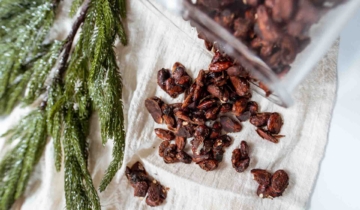The hormonal journey of a woman’s life is marked by several significant phases, each one characterized by unique (and annoying!) changes and challenges. This journey begins with puberty, bounces through periods of premenstrual syndrome (PMS), before winding through pre-, peri-, and post-menopause.

Puberty: The Onset of Hormonal Change
Puberty marks the beginning of reproductive maturity in females. According to the Canadian Research Data Centre Network and various studies, the average age of puberty onset in Canadian girls has been gradually declining, starting as early as 10 years for some, aligning with global trends suggesting environmental and nutritional factors at play.1,2,3, This phase is characterized by the increased production of hormones like estrogen and progesterone, which are responsible for the development of secondary sex characteristics and the start of menstrual cycles which is formally known as menarche.
Have you noticed signs of puberty in your child earlier than you expected? How might you support them through this change?
PMS: Navigating Monthly Turbulence
Following puberty, many women begin experiencing premenstrual syndrome (PMS), which affects physical health, emotions, and behaviour during certain days of the cycle, generally just before menses. 30 to 70% of menstruating women in Canada experience some form of premenstrual syndrome, which significantly affects their daily activities, as reported by the BC Women’s Hospital.4 Symptoms can include:
- Tender breasts
- Pelvic cramps
- Fatigue
- Cravings for foods
- Mood swings
- Changes to libido
- Acne
- Feeling bloated
Are your PMS symptoms manageable or do they disrupt your daily life?
PMS Vitex, containing Chaste Tree (Vitex agnus-castus), is a natural remedy that helps alleviate PMS symptoms by balancing hormone levels, particularly progesterone, which can be beneficial for those experiencing discomfort during this phase.
Pre-Menopause: The Lead-Up
Pre-menopause is the period (no pun intended) in a woman’s life before menopause, during which her hormonal levels begin to fluctuate, leading to changes in the menstrual cycle length and frequency. During this stage, maintaining a balanced diet and healthy lifestyle, along with appropriate supplementation, can be beneficial. This is when you can start to consider something like MenoSupport Complex. The organic soy isoflavones can reduce how quickly estrogen falls, easing your symptoms. The magnesium will help support sleep and mood, while hibiscus will help with overall cardiovascular health.
As you approach menopause, have you started experiencing changes in your menstrual cycle or new symptoms? What strategies have you considered to manage these changes?

Peri-Menopause: The Transition Phase
Now. You’re in it.
Peri-menopause is like nature’s own version of an unpredictable rollercoaster, often starting in your mid-40s to 50s. During this time, your hormone levels begin to fluctuate – up one minute, down the next – bringing along some unwanted guests: hot flashes that make you feel like you’re in the tropics, night sweats that make you feel like you’re swimming in your sleep and mood swings that could give soap operas a run for their money. It’s a challenging time, but knowing what’s happening can help you manage these changes more effectively. You can still take MenoSupport Complex throughout menopause, and if you’re suffering from hot flashes and night sweats, you can add MenoForce.
MenoForce is made from the fresh, organically grown leaves of the sage plant, scientifically known as Salvia officinalis. Sage has been revered throughout history for its medicinal properties and is particularly noted for its effectiveness in reducing excessive sweating.5 This makes it an ideal choice for women going through menopause, who often struggle with sudden and intense hot flashes and night sweats. Clinical studies have supported the efficacy of MenoForce in reducing menopausal symptoms.6,7 Women who have taken this product report significant reductions in the frequency and intensity of hot flashes and night sweats.
MenoForce is easy to use, requiring just one tablet daily. This simplicity, combined with its natural origin, makes it a preferred choice for many women seeking a non-hormonal treatment option that does not come with the side effects often associated with synthetic medications.
During menopause, are you more troubled by physical symptoms like hot flashes and night sweats, or by emotional changes like mood swings?

Life After Menopause
Post-menopause is the stage following menopause, defined as the period after a woman has not had a menstrual cycle for 12 consecutive months. During post-menopause, the ovaries produce significantly less estrogen and progesterone. Symptoms such as hot flashes may lessen for some women, but others continue to experience them, along with increased risks of osteoporosis and cardiovascular disease due to the lower levels of protective hormones. Weight-bearing exercise, nutrition, and strategic supplementation will be your friends during this stage.
Post-menopause brings a higher risk of certain health conditions. What steps are you taking to mitigate these risks, and how could supplements support your health goals?
Article By:
Dr. Owen Wiseman, ND
Medical Advisor
Dr. Owen Wiseman, voted Ottawa’s Best Health Educator in 2022 and 2023, moves beyond quick fixes to deliver life-altering health transformations. As a naturopathic doctor and Medical Advisor to A.Vogel, he’s a sought-after public speaker, consultant, and valuable contributor to various boards and committees. His passion is promoting nature therapy’s clinical benefits and helping Canadians get WISE about their health!

References:
- Al-Sahab, Ban, et al. “Age at menarche in Canada: results from the National Longitudinal Survey of Children & Youth.” BMC Public Health 10 (2010): 1-8.
- Ramraj, Balaji, V. Meenakshi Subramanian, and G. Vijayakrishnan. “Study on age of menarche between generations and the factors associated with it.” Clinical Epidemiology and Global Health 11 (2021): 100758.
- Gallant, François, et al. “Puberty timing and relative age as predictors of physical activity discontinuation during adolescence.” Scientific Reports 13.1 (2023): 13740.
- “Premenstrual Syndrome (PMS) or Premenstrual Dysphoric Disorder (PMDD).” BC Women’s Hospital, www.bcwomens.ca/health-info/sexual-reproductive-health/gynecology-and-pelvic-health/pmspmdd. Accessed 3 May 2024.
- Moradi, Maryam, et al. “The Effect of Salvia Officinalis on Hot Flashes in Postmenopausal Women: A Systematic Review and Meta-Analysis.” International Journal of Community Based Nursing and Midwifery 11.3 (2023): 169.
- Bommer, S. A. G. E., P. Klein, and A. Suter. “First time proof of sage’s tolerability and efficacy in menopausal women with hot flushes.” Advances in Therapy 28 (2011): 490-500.
- Wilfried, Dimpfel, Chiegoua Dipah Gwladys Nina, and Bommer Silvia. “Effectiveness of Menosan® Salvia officinalis in the treatment of a wide spectrum of menopausal complaints. A double-blind, randomized, placebo-controlled, clinical trial.” Heliyon 7.2 (2021).





 No products in the cart.
No products in the cart.